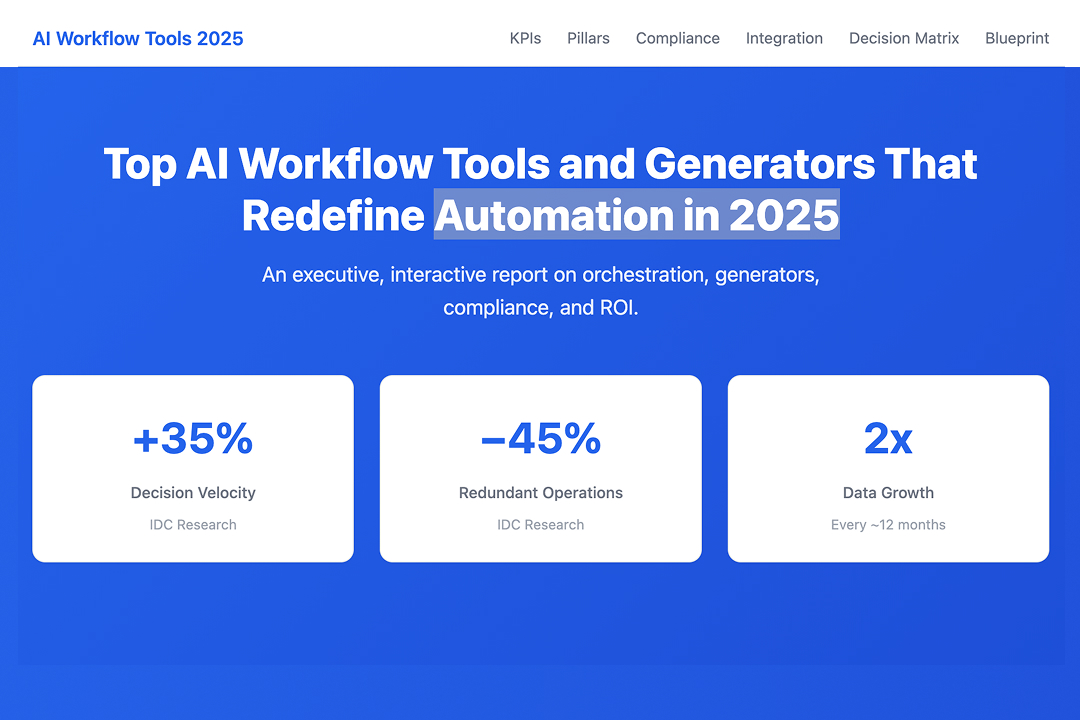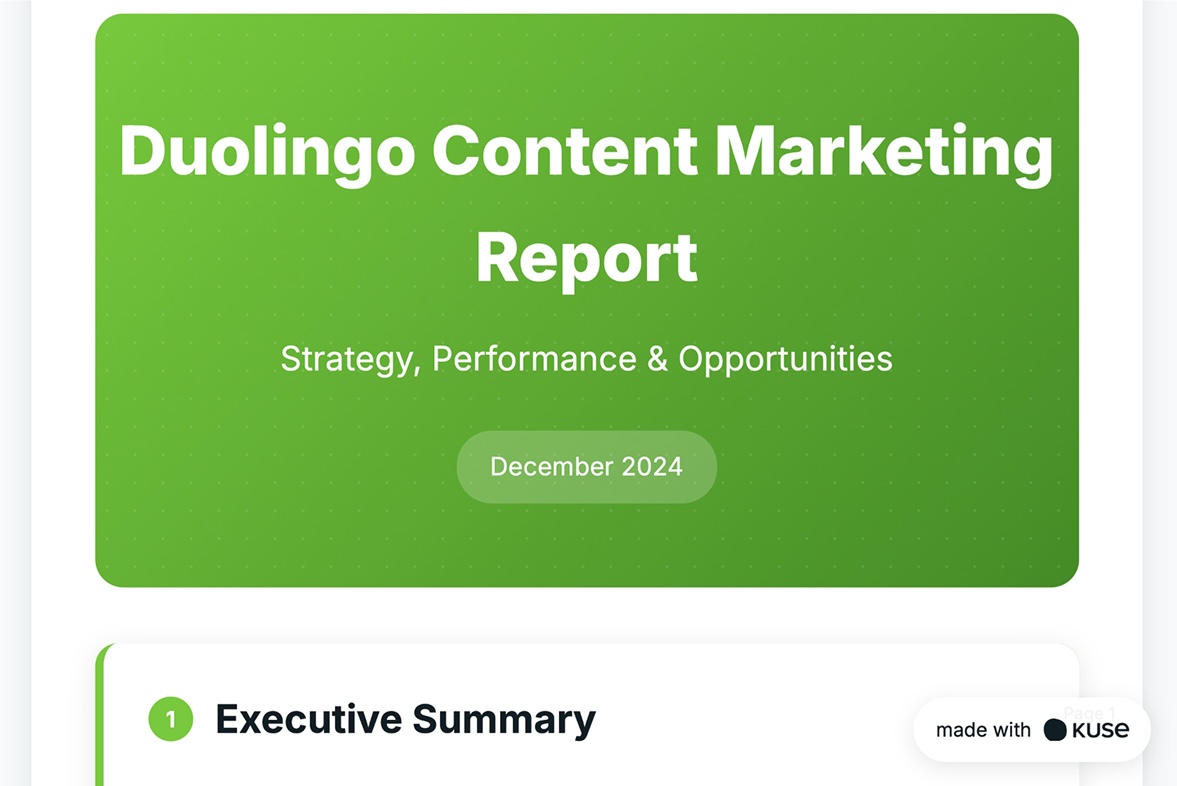Top AI Workflow Tools and Generators That Redefine Automation in 2025
Discover the top AI workflow automation tools and generators transforming business operations in 2025. Learn how AI workflows improve compliance, security, and cross-system orchestration for smarter, faster decisions.

Why AI Workflow Tools Matter in 2025
AI workflow tools are no longer “nice-to-have” add-ons—they’ve become the central nervous system of intelligent organizations.
With data volume doubling every 12 months and teams relying on dozens of disconnected software systems, the need for seamless orchestration has reached a breaking point.
AI workflow automation platforms bring order to this chaos. They connect CRMs, analytics platforms, communication tools, and databases into a living pipeline, where each event triggers intelligent responses downstream.
According to IDC, organizations implementing AI orchestration frameworks experience a 35% improvement in decision-making speed and a 45% reduction in redundant operations. In 2025, the conversation has shifted from “Can we automate this?” to “How fast can we connect and optimize everything we already use?”
What Makes a Great AI Workflow Tool
A great AI workflow tool does more than automate—it creates a feedback-driven ecosystem where decisions improve with every cycle. Let’s unpack what defines the leaders in this space.
1. End-to-End Integration
True AI orchestration means no silos. The best platforms integrate every layer of your data infrastructure—from structured CRM entries to unstructured Slack messages or IoT signals.
For instance, an insurance company using Pega or Appian can pull data from policy systems, emails, and third-party risk models into one automated underwriting process. This kind of integration eliminates friction between data capture, evaluation, and execution.
Integration isn’t just about APIs—it’s about semantic alignment. Modern AI workflow tools use connectors that understand context, ensuring the meaning of “customer,” “case,” or “opportunity” stays consistent across platforms.
2. Adaptive Intelligence
While traditional RPA follows static rules, AI workflow tools learn from outcomes. If an email classification workflow mislabels messages, the system adjusts thresholds or retrains models automatically.
Adaptive systems rely on feedback loops—feeding real performance data back into machine learning pipelines. This self-learning capability transforms workflows from rigid automation into dynamic cognitive systems that evolve alongside business changes.
3. Low-Code / No-Code Flexibility
Democratization is key. AI workflows must be accessible to business users while remaining extensible for engineers.
Modern tools provide drag-and-drop interfaces combined with natural language prompts. A marketing manager can now type “Build a workflow to alert sales when a lead score exceeds 90,” and the platform auto-creates it—integrating CRM, Slack, and email steps automatically.
Meanwhile, developers can enrich this workflow by embedding APIs, custom models, or webhook triggers.
4. Built-In Governance and Compliance
AI workflows often automate decisions that affect customers, finances, and legal obligations. That’s why leading platforms build compliance logic into their architecture—from encrypted data transit to explainable decision trails.
For example, Appian’s audit trail ensures every automated action (like rejecting a loan or generating a quote) is timestamped, attributed, and reproducible.
In regulated sectors like healthcare or banking, such traceability turns AI from a potential liability into a trusted asset.
Top AI Workflow Automation Tools in 2025
AI Workflow Generators: The Next Step Beyond Automation
If workflow tools automate logic, AI workflow generators automate creation itself.
These systems interpret natural language prompts and dynamically build workflows—including triggers, conditions, and integrations—without human configuration.
Imagine typing:
“Create an AI pipeline that routes customer complaints by sentiment, summarizes them weekly, and sends an insight report to the CX manager.”
An AI workflow generator like Zapier AI or Aisera Composer can instantly:
- Detect “sentiment” as an NLP model requirement.
- Connect your support inbox and data visualization tool.
- Generate logic for weekly aggregation.
- Design the workflow’s end-to-end structure in seconds.
This shift from configuration to co-creation represents the next wave of workflow intelligence.
It enables rapid experimentation, allowing non-technical teams to build, test, and deploy automation in hours rather than months.
More advanced generators also integrate context memory, remembering prior user actions or templates to improve new workflows automatically—essentially becoming AI copilots for business orchestration.
Learn how AI workflow pipelines function end-to-end in What Is AI Workflow Automation and How to Build Smarter Business Pipelines in 2025.
Compliance and Security in AI Workflow Tools
As AI workflows increasingly touch sensitive data—from health diagnostics to customer financials—compliance isn’t optional; it’s existential.
Modern tools address this through three key frameworks:
1. Explainable AI (XAI)
Top workflow tools now feature visual dashboards that allow users to trace why an action occurred. For example, if an AI model denies a credit application, compliance teams can review which parameters (credit score, income, employment duration) influenced that decision.
2. Zero-Trust Architecture
Leading platforms embed zero-trust principles, meaning every access request—human or automated—is continuously verified. Encryption at rest and in transit, plus granular permissioning, ensures sensitive workflow data is never exposed.
3. Regulatory Alignment and Data Residency
Many workflow generators now offer geo-specific data controls. Financial institutions can choose to store data exclusively in EU servers (GDPR) or U.S. regions (CCPA).
Built-in data retention policies and model versioning ensure that even AI predictions comply with audit timelines.
4. Continuous Compliance Monitoring
Unlike static systems, AI workflow platforms track compliance status dynamically. Dashboards alert teams when new automation exceeds approved thresholds or interacts with restricted datasets.
This shift from periodic to real-time compliance represents a major leap forward in risk management.
Integrating AI Workflows into Enterprise Systems
Integrating AI workflows requires a blend of architecture design and change management. Successful organizations follow a layered rollout:
- Discovery: Identify the most repetitive or data-intensive tasks.
- Pilot and Validation: Launch small-scale workflows, collect feedback, and fine-tune ML models.
- System Integration: Connect existing tools—CRM, ERP, analytics—using standardized APIs.
- Feedback and Governance: Create monitoring dashboards that track output quality and compliance metrics.
- Cultural Adoption: Train employees not only how to use workflows but when to trust and refine them.
Enterprises that follow this path typically report faster scaling and smoother cross-department adoption.
Explore applied integrations in AI-Driven Workflow Automation in Dealerships: From Service Communications to Compliance.
The Emerging AI Workflow Stack
In 2025, leading organizations use a three-tier AI workflow architecture that blends automation, intelligence, and experience layers.
1. Automation Layer (Execution Backbone)
This layer handles workflow orchestration—triggering actions between systems like Salesforce, Slack, and Workday. Tools such as Appian or Pega act as the “conductor,” ensuring tasks flow smoothly across systems.
2. Intelligence Layer (Analytical Core)
Here lies the brain: machine learning models, NLP engines, and predictive analytics. It interprets input data, draws conclusions, and updates downstream systems.
Advanced systems embed fine-tuned LLMs for summarization or GPT-based reasoning, allowing contextual decision-making that goes beyond simple triggers.
3. Experience Layer (User Interface)
This is where users interact with the AI. Instead of navigating dashboards, they can simply ask, “Show me this week’s workflow exceptions” via Slack or Teams.
AI copilots then deliver answers directly inside the collaboration tool, turning every employee into a “workflow participant.”
Together, these layers form a unified orchestration fabric—allowing business logic, data intelligence, and user experience to function as one system.
Common Challenges When Choosing AI Workflow Tools
Choosing the right AI workflow tool isn’t about price—it’s about alignment between data maturity, organizational readiness, and scalability goals.
One major challenge is vendor fragmentation. Many tools specialize in single functions (data sync, analytics, RPA), leaving enterprises juggling multiple licenses. Organizations should look for platforms that integrate seamlessly via open APIs to avoid future lock-in.
Another issue is data inconsistency. AI workflows thrive on structured, high-quality data; missing or duplicated entries can degrade model accuracy. Before adoption, companies must invest in data standardization and governance pipelines.
Change management remains equally critical. Employees must understand that AI is not replacing them but augmenting their roles. Training programs and internal ambassadors can help build trust and accelerate adoption.
Lastly, cost visibility is often overlooked. While no-code tools reduce engineering burden, large-scale orchestration can still generate hidden costs—API calls, model retraining, or compliance audits. A transparent ROI model should accompany every AI workflow deployment.
By addressing these challenges proactively, companies can ensure their automation investments evolve into sustainable competitive advantages, not short-lived experiments.
Conclusion
AI workflow tools and generators have redefined how organizations operate, transforming workflows from static rule sets into dynamic, learning systems.
By combining automation with adaptive intelligence and compliance rigor, these tools empower teams to move from reacting to predicting, from managing data to mastering it.
In 2025, the best businesses won’t just adopt AI—they’ll architect their workflows around it.
FAQs
1. What are AI workflow tools?
AI workflow tools connect automation, machine learning, and orchestration to enable seamless communication between business systems. They help organizations reduce manual work and make faster, smarter decisions.
2. What is an AI workflow generator?
An AI workflow generator uses natural language prompts or templates to automatically create end-to-end workflows—identifying steps, data connections, and actions in seconds.
3. How do AI workflow tools enhance compliance?
They provide explainable AI dashboards, role-based permissions, and real-time audit logs, ensuring every automated decision can be tracked and justified for regulators.
4. Which AI workflow tools are ideal for small teams?
Tools like Whalesync and Zapier AI are lightweight, affordable, and perfect for startups or marketing teams that want quick integration without coding.
5. What are common pitfalls in adopting AI workflow automation?
Poor data hygiene, lack of governance, fragmented tools, and weak user onboarding. Overcoming these requires strong leadership, data readiness, and continuous monitoring.
6. How can AI workflow tools transform dealership operations?
They automate lead distribution, service scheduling, and compliance checks—creating consistent, personalized experiences across departments.




